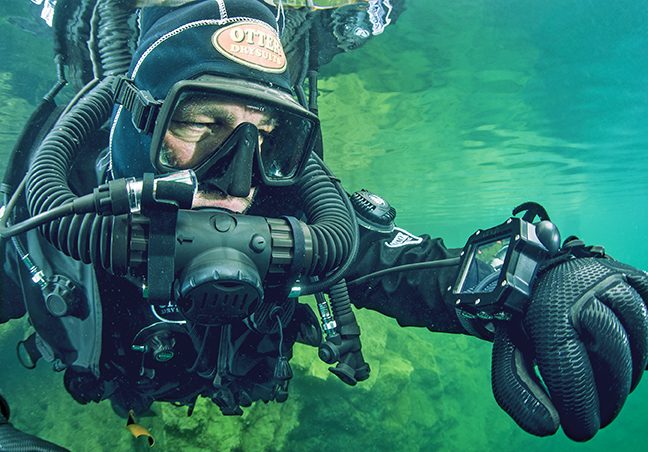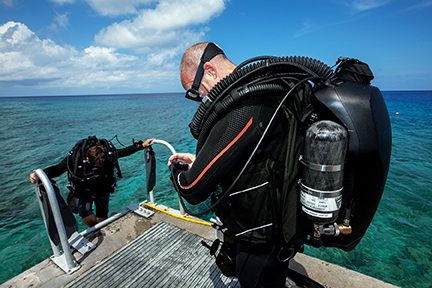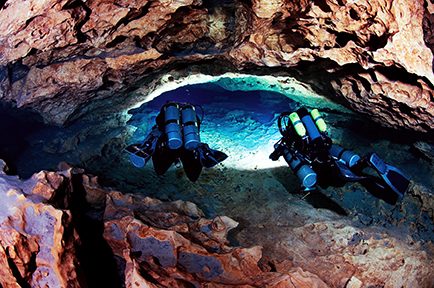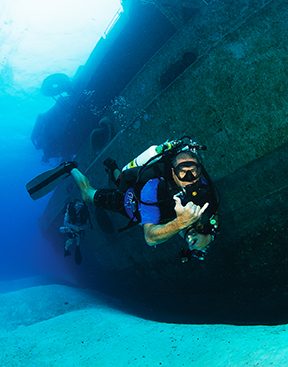CLOSED-CIRCUIT REBREATHERS (CCRs) have significantly grown in popularity over the past few years. They are becoming more of a norm in the technical diving community, and recreational and scientific divers are also discovering their benefits. You probably know at least one CCR diver, and they often proclaim its benefits. How accurate are these claims? Are CCR divers trying to show open-circuit divers the light, or are they trying to justify their $10,000 purchase? Let’s evaluate a few popular claims about CCRs.
REBREATHERS ARE MUCH
LIGHTER THAN DOUBLES.
At face value, this is a true statement. A set of double steel cylinders like what technical divers commonly use weighs more than 100 pounds, while a CCR is about 50 pounds depending on the model. But that’s not the complete picture. Double cylinders offer redundancy through a manifold or a sidemount configuration. You must carry a separate bailout cylinder to have redundant breathing gas while diving a CCR. For a decompression dive, a CCR diver also takes at least one cylinder of decompression gas in case of CCR failure. It’s important to plan your breathing-gas needs and carry the correct equipment based on your dive plan. While the CCR itself weighs less than a set of doubles, you must also consider the weight and bulk of additional cylinders.
YOU HAVE ENOUGH GAS SUPPLY
TO LAST FOR HOURS-LONG DIVES.
You indeed have an extended gas supply on a CCR, and you also carry more contingency gas than you would on open circuit. You may not want to do long dives or extended bottom times, but there are safety benefits to having hours rather than minutes of reserve breathing gas.

CCR instructor Pete Mesley checks his display while diving at Vobster Quarry in the UK.
REBREATHERS ARE
CHALLENGING TO UNDERSTAND.
This notion is more likely to keep people away from rebreathers than attract them. There is no denying that rebreathers are more complex than open-circuit scuba equipment. But they aren’t as complex as you might have heard. Most people can understand the concepts of rebreather operation, but diving on a rebreather requires more than just understanding. Self-discipline is essential. You might hear in rebreather training, “This machine will try to kill you. It is your job to stop it from succeeding.” It sounds melodramatic, but it is true.
The machinery’s complexity adds more potential failure points than open circuit. A failure in one of the many O-ring seals, electronics, or carbon dioxide absorbent can be fatal. Meticulous care is necessary to reduce the risks of equipment failure. Every rebreather manufacturer provides checklists that you must complete before every dive. Skipping the predive checklist or ignoring items that fail the predive check is asking for trouble. Rebreathers need particular care after the dive, and ignoring these procedures can lead to bad outcomes. These pre- and postdive procedures are not challenging, but they are essential and time-consuming. If you usually put your open-circuit rig in the back of the truck after the dive and don’t look at it for a few days, you’ll have to change that habit if you switch to a rebreather.

This mixed team reveals a CCR diver carrying more gas than his open-circuit partner at Madison Blue Spring, Florida.
LEARNING TO DIVE A REBREATHER IS
LIKE LEARNING TO DIVE ALL OVER AGAIN.
Besides money, you must also invest time. The dedication aspect of CCR diving is where a meticulous, self-disciplined person will excel. You cannot buy a rebreather and immediately start doing deep trimix dives. There is a learning curve that is often like starting over. You will need time to relearn how to dive and master buoyancy on a CCR, even if you have many years of open-circuit experience.
Most training agencies require a minimum number of training hours before proceeding to the next level. You will begin in a CCR Air Diluent Diver course, which is like the open-water diver course of the rebreather world. After this course, you will be certified to dive to 100 feet (30 meters) with no required decompression stops. If you want to go deeper and do more complex dives, the next step is an Air Diluent Decompression Diver course. To enroll in this course, you usually need a minimum of 30 to 50 dives or 30 to 50 hours on the CCR. Certification at this level allows you to dive to 130 feet (40 meters) and includes the ability to conduct decompression stops. Prerequisites and course objectives vary depending on the training agency. Beyond Air Diluent Decompression Diver, you can take courses that teach even deeper, mixed-gas diving using helium (trimix). Deep dives using mixed gas are where rebreathers shine.


Above: A diver participates in a rebreather class on the wreck of the Kittiwake in Grand Cayman.
Left: Greg Such and Kevin Gurr do a test dive at Divetech, Grand Cayman.
YOU WILL RECOUP YOUR INVESTMENT
BY SAVING ON HELIUM COSTS.
There is no doubt that rebreathers are expensive. You can easily spend $10,000 on a rebreather plus training. But if you are a trimix diver, you can save on helium. The breathing mix for deep dives contains helium to reduce nitrogen narcosis, but it is expensive. At the time of this writing, helium is $3 to $5 per cubic foot in the Midwest. If you are filling double 95s (190 total cubic feet) with a mix containing 45 percent helium, the helium alone is $256.50 (based on $3 per cubic foot). Three liters is a typical size for rebreather cylinders, accommodating roughly 26 cubic feet of breathing gas. Filling that cylinder with a mix containing 45 percent helium would require $35.10 in helium. It’s quite a savings, but you have to invest a lot of money before getting to the savings. Unless you often dive trimix, you may never recoup the investment.
Helium availability may be a more compelling reason than the cost to dive a CCR — the price and supply vary widely by geographic region. Sometimes there are mysterious shortages, resulting in dive centers not being able to obtain it at any cost. Given that helium is not always available but always expensive, I prefer to be as efficient with it as possible. You can fill seven rebreather cylinders with the same volume of identical trimix that it would take to fill a set of double 95s. Again, you’ll have to do that often to recoup the initial expenditure for new cylinders to fit your rebreather.
SOME LOGISTICS ARE DIFFICULT.
My buddy and I have been diving open circuit for many years, and we travel around the Great Lakes region of North America every summer to wreck dive. For some reason, ships never sink near big cities with nice dive centers — they always seem to be in the middle of nowhere. My buddy bought an enclosed trailer that we loaded with multiple sets of doubles, deco bottles, and other bits of dive paraphernalia for each excursion.
On one trip, we arrived with our dive shop on wheels to find our dive buddies for the week, a couple of CCR divers who were already there and settled in. Additional preparation and maintenance steps can take longer than with open circuit, so CCR divers often need to start early. It’s also crucial to plan how to travel with the cylinders you need and what’s available at your destination — breathing gas may be limited and expensive in certain areas.
These two divers were clearly experienced, however, and had worked out their routine. The best part was that they had all their gear for the week in the back of a pickup truck with room for a cooler, barbecue grill, suitcases, groceries, and who knows what else. I looked at our trailer, and the penny finally dropped.
So what is the bottom line? Are rebreathers all they are purported to be, or are they just expensive tools? The truth is they are somewhere in between, depending on your point of view.
When considering making the leap into rebreather diving, you must carefully look at it from all angles, including the cost, how much you dive, your resilience, and the type of diving you do. A rebreather is not for everyone, but it may be the right choice for you, especially if you know what you are getting into and you prepare to put in the time to get good training and lots of practice.
Alert Diver — Q2 2022